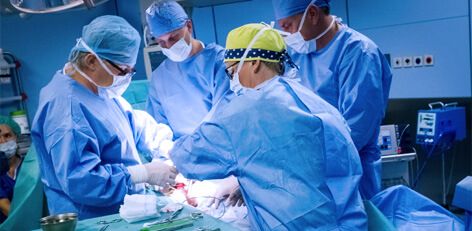Lymphadenectomy is a medical procedure performed during prostatectomy or as a form of salvage therapy if lymph node cancer recurrence is detected after primary treatment.

Many Patients diagnosed with prostate cancer fear the possibility of cancer metastasis to other organs because of disease progression. In the case of prostate cancer metastatic disease is most likely to occur in lymph nodes and bone, thus in select Patients lymphadenectomy (the surgical removal of regional lymph nodes) is an element of the treatment process.
WHAT IS LYMPHADENECTOMY?
Lymphadenectomy, in the case of prostate cancer is a surgical procedure during which lymph nodes in the pelvic region containing cancer cells are surgically removed. It is a standard procedure performed in Patients with prostate cancer, that have a risk of lymph node metastasis >5%. In select cases lymphadenectomy provides the promise of making a full recovery from prostate cancer. Salvage lymphadenectomy is a procedure used when cancer recurrence in a lymph nodes is detected after primary treatment.
WHAT IS THE PURPOSE OF THE PROCEDURE?
The primary reason for performing lymphadenectomy during prostatectomy is slowing down or completely stopping the further spread of prostate cancer, this is achieved by surgical removal of the surrounding lymph nodes affected by prostate cancer. Unfortunately, there is still not enough high quality data to support benefits of this procedure in all patients. Despite this the procedure is performed on a routine basis because it enables the introduction of supplementary therapies if cancer cells are confirmed to be present in the Patient’s lymph nodes.
QUALIFICATION FOR TREATMENT
Lymph nodes suspicious of cancer metastasis are identified in highly sensitive PSMA-PET diagnostic imaging procedures, and subsequently removed by an experienced urologist. Currently available clinical data suggests that select Patients can benefit from this procedure, this holds especially true for cases where only a few lymph nodes contain cancer cells. Qualification for lymphadenectomy can only be performed by a team of doctors experienced in lymphadenectomy procedures on the basis of a detailed risk analysis.
HOW IS THE PROCEDURE PERFORMED?
Lymphadenectomy accompanying radical prostatectomy is performed during open or laparoscopic surgery. Lymph node removal usually increases the length of a prostatectomy procedure by 30 to 60 minutes. Salvage lymphadenectomy performed due to cancer recurrence usually utilizes the open surgery method since it enables palpation and examination of the lymph nodes. Additionally, in certain cases, a radioactive marker or dye is used, which helps identify suspicious lymph nodes.
HOSPITALIZATION
Hospitalization after a lymphadenectomy procedure usually takes 5-7 days.
WHO IS A CANDIDATE FOR THE PROCEDURE?
Salvage lymphadenectomy is a procedure for Patients with cancer recurrence in singular lymph nodes, confirmed by diagnostic imaging, following their primary treatment. Bone metastasis can be a contraindication to perform lymphadenectomy and metastasis to further organs is a definitive contraindication. Salvage lymphadenectomy can offer hope of full recovery if it is performed at an early stage of metastasis.
HOW CAN I SCHEDULE MY PROCEDURE?
To schedule your procedure qualifying consultation contact us using the free online consultation. We will be glad to anlyze your medical documentation and answer any question you might have.
To schedule your procedure please contact our Patient Coordination Department by calling +48 512 077 461 or sending an email to contact@hifuclinic.eu.
See also

4KSCORE® molecular test
4Kscore®Test allows to predict development of clinically significant prostate cancer...

Laparoscopic Radical Prostatectomy
The aim of the LRP therapy is to prevent further development of the disease through prostate resection.

Penile Prosthesis Insertion
The aim of this procedure is to restore man's ability to develop erection, e.g., after radical prostatectomy.
